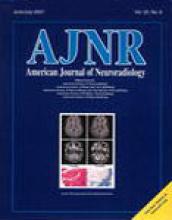In this issue of the AJNR, Mitchell et al (page xxxx) describe endovascular management of vein of Galen malformations presenting in the neonatal period. The authors have documented in a relatively small number of patients their experience with management of these neonates, demonstrating the feasibility of endovascular treatment and the outcome they could achieve.
Criteria for treatment included uncontrollable congestive heart failure in neonates diagnosed with vein of Galen malformations, and they used a variety of approaches (retrograde transvenous, transtorcular, transarterial) and various embolic materials (coils,glue).
Endovascular treatment of vein of Galen malformations continues to be among the most challenging aspects in all of interventional neuroradiology. Although there have been significant improvements in the tools that are now available, the number of patients referred with this diagnosis to any given center is usually small and the experience, therefore, limited. While it intuitively would make sense to refer these patients to a regional or national center with expertise in the management of this rare disorder, this is often not a viable option in view of the medical instability of these neonates precluding transfer. Antenatal diagnosis by sonography and MR imaging (1) would allow for consultation to be obtained and transfer of the mother to be arranged to facilitate delivery at a center that has significant experience in the overall management of vein of Galen patients.
A significant number of neonates with vein of Galen malformation presenting in congestive heart failure can be managed successfully with aggressive medical therapy under the supervision of an experienced team of pediatric cardiologists and intensivists (2–4).
If, despite these best efforts, the high output failure continues to worsen, then a decision to treat the vein of Galen malformation itself needs to be made.
It is in our opinion critical at that point in time to take into consideration the status of the brain, heart, kidneys, and liver to determine whether endovascular treatment should be offered or withheld (4).
With respect to the choice of the arterial versus the venous or transtorcular approach, the following observations should be kept in mind. While the venous approach may be appealing because of its lesser technical challenge it is problematic from a conceptional point of view and is clearly wrong when the vein of Galen enlargement was not recognized to be caused by an adjacent pial arteriovenous malformation draining into it. In the considerable experience of Lasjaunias in Paris, Berenstein in New York, and we in Toronto during the past 15 years, we extremely rarely have had to resort to the venous approach in these neonates (4). As the published data would indicate and as was shown by the authors in the current issue of the AJNR, the arterial approach is more efficient in accomplishing a lasting reversal of the congestive high output failure as compared with the venous treatment. It is certainly not necessary to close the entire vein of Galen malformation to accomplish a reversal in the high output failure as reduction by about 30% to 40% of the arteriovenous shunt (two or three of the largest arterial feeders) will likely have this desired impact. Retrograde venous embolization appears to require a near- complete closure of the venous outlet in order to achieve a similar result.
Once the medical condition stabilizes, the focus of attention should then be directed toward the brain. Similar to neonates with vein of Galen malformations presenting with mild or moderate congestive heart failure, frequent developmental and MR assessments (every 3 months) are recommended during the first year to verify that all milestones are met and no hydrodynamic disorders occur. It is, in fact, rare in our experience to have to perform additional endovascular treatment during the first year and not infrequently have we observed progressive closure of the vein of Galen malformation over the next few years (3).
The goal of treatment in the management of vein of Galen malformations, whether they present in neonates with uncontrollable congestive heart failure or subsequently with an enlarging head circumference will not just be to preserve life but to produce a normally developing child. As the experience grows, the decision whether to treat or not and to choose the optimal moment (and method) for treatment has and will become more clear. Mitchell et al's study serves to add in this process.
- Copyright © American Society of Neuroradiology












